8.01.2018
NOAA's GOES-S weather satellite, slated for 2018 launch, arrives at KSC

An Air Force C-5M Super Galaxy delivers the NOAA's latest weather satellite to Kennedy Space Center on Monday.
-
A rocket from the same Atlas V family launched its $1 billion forerunner in 2016, also known as GOES-R, and was designated GOES-16 after coming online. GOES-S will follow the same pattern and become GOES-17 after achieving the intended orbit and completing tests.
Quelle: Florida Today
---
Update: 30.01.2018
.
NASA Invites Media to Upcoming NOAA GOES-S Satellite Launch
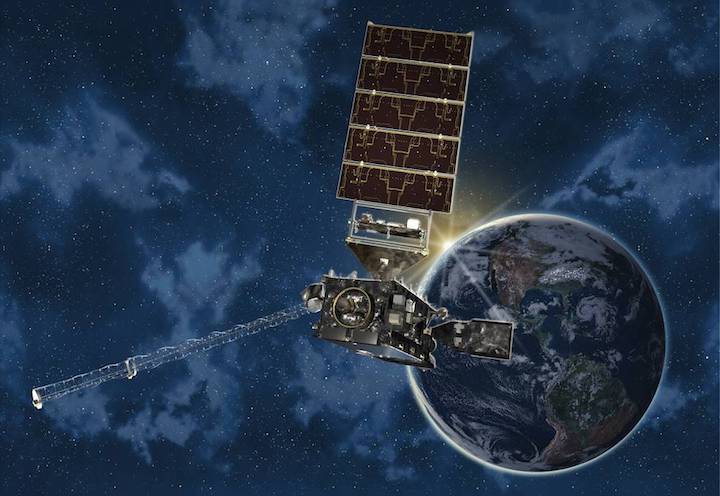
Media accreditation is open for the launch Thursday, March 1, of the second in the National Oceanic and Atmospheric Administration’s (NOAA’s) series of next-generation geostationary weather satellites.
NOAA’s Geostationary Operational Environmental Satellite-S (GOES-S) is scheduled to launch at 5:02 p.m. EST on a United Launch Alliance Atlas V rocket from Cape Canaveral Air Force Station (CCAFS) in Florida. GOES-S is the second in the GOES-R Series of weather satellites that includes GOES-R (now GOES-16), -S, -T and -U.
Media prelaunch and launch activities will take place at CCAFS and NASA’s neighboring Kennedy Space Center. International media without U.S. citizenship must apply by 4:30 p.m.Tuesday, Feb. 13, for access to Kennedy media activities only. U.S. media must apply by 4:30 p.m. Monday, Feb. 19. All media accreditation requests should be submitted online at:
For questions about accreditation, please email ksc-media-accreditat@mail.nasa.gov. For other questions, or additional information, contact Kennedy’s newsroom at 321-867-2468.
GOES-S will be renamed GOES-17 when it reaches geostationary orbit. Once the satellite is declared operational late this year, it will occupy NOAA’s GOES-West position and provide faster, more accurate data for tracking wildfires, tropical cyclones, fog and other storm systems and hazards that threaten the western United States, Hawaii, Alaska, Mexico, Central America and part of South America.
NOAA manages the GOES-R Series program through an integrated NOAA/NASA office and oversees the acquisition of the program ground system. NASA oversees the acquisition of the spacecraft, instruments and launch vehicles. Lockheed Martin Space of Littleton, Colorado, built the spacecraft and is responsible for spacecraft development, integration and testing.
Mission operations will be performed by NOAA at the NOAA Satellite Operations Facility in Suitland, Maryland. Harris Corp. of Melbourne, Florida, provided the main instrument payload, the Advanced Baseline Imager, and the ground system, which includes the antenna system for data receipt. NASA’s Launch Services Program is responsible for launch management. United Launch Alliance of Centennial, Colorado, is the provider of the Atlas V launch service.
Quelle: NASA
---
Update: 31.01.2018
.
Atlas V to Launch GOES-S

- Rocket: Atlas V 541
- Mission: Geostationary Operational Environmental Satellite-S (GOES-S)
- Launch Date: Thursday, March 1, 2018
- Launch Time: 5:02 p.m. EST
- Live Broadcast: Look for how you can watch live
- Launch Location: Space Launch Complex 41, Cape Canaveral Air Force Station
Mission Description: GOES-S is the second of four satellites to be launched for the National Oceanic and Atmospheric Administration (NOAA) in a new and advanced series of spacecraft. Once in geostationary orbit, it will be known as GOES-17. Like the other satellites in the series, GOES-S carries a suite of sophisticated Earth-sensing, lightning-detecting, solar imaging and space weather monitoring instruments. The advanced technology on board GOES-S will provide critical data and imagery in near-real time on severe weather events such as thunderstorms, tornadoes, hurricanes and flash floods, as well as hazards like fog, aerosols, dust storms, volcanic eruptions and forest fires.
Launch Notes: ULA and our heritage rockets have launched all of the operational GOES satellites, including GOES-R in November 2016. GOES-S marks the sixth Atlas V to launch in the 541 configuration, the first of which was the rocket that launched NASA’s Curiosity rover to Mars in 2011.
Quelle: ULA
---
Update: 9.02.2018
.
Rocket Launch: March 1, 2018 5:02 PM EST | ULA Atlas V GOES-S
Mar 01, 2018 05:02 PM Cape Canaveral Air Force Station, Space Launch Complex 41ULA Atlas V GOES-S

MISSION
United Launch Alliance (ULA) will launch the GOES-S mission on an Atlas V rocket to place the GOES-S weather satellite in orbit for the National Oceanic and Atmospheric Administration (NOAA). Built by Lockheed Martin, GOES-S is the second in a series of four advanced geostationary weather satellites. Atlas V will fly in the 541 vehicle configuration with a five-meter fairing, four solid rocket boosters and a single-engine Centaur upper stage.
Quelle: Kennedy Space Center
---
Update: 17.02.2018
.
GOES-S weather observatory hoisted atop Atlas 5 rocket

NOAA’s next geostationary weather satellite, GOES-S, was raised on top of an Atlas 5 launcher Friday at Cape Canaveral in preparation for liftoff March 1 to keep watch over the Pacific Ocean and the Western United States.
Fully fueled for a planned 15-year mission in space, the roughly 11,500-pound (5,200-kilogram) GOES-S spacecraft arrived at the base of the Vertical Integration Facility at Cape Canaveral’s Complex 41 launch pad early Friday after a road trip from the nearby Astrotech satellite processing facility in Titusville, Florida.
Cranes hoisted the satellite, already encapsulated inside the United Launch Alliance Atlas 5’s Swiss-built nose cone, atop the two-stage rocket inside the vertical hangar, a NASA spokesperson said.
The addition of the GOES-S satellite completes assembly of the Atlas 5 rocket. Ground crews began stacking the rocket Jan. 31 with the mounting of the Atlas 5’s first stage on a mobile platform inside the VIF, then added four solid rocket boosters and a Centaur upper stage cocooned inside the payload fairing’s lower section.
ULA technicians accomplished a combined systems test after assembling the major components of the rocket, and further testing of electrical interfaces between the Atlas 5 and the GOES-S satellite are planned next week.
A launch readiness review Feb. 27 will give approval to roll the Atlas 5 rocket from the VIF to the launch pad, assuming all launcher, spacecraft, range and ground systems are ready. The rollout is scheduled for the morning of Feb. 28, followed by filling of the Atlas 5’s first stage with RP-1 kerosene fuel.
The ULA launch team will load super-cold liquid oxygen into the first stage, and a liquid hydrogen and liquid oxygen mixture into the Centaur upper stage, during the March 1 countdown. The two-hour launch window opens at 5:02 p.m. EST (2202 GMT).
The Atlas 5 rocket will deploy the GOES-S satellite into an elliptical transfer orbit more than three hours after liftoff. The Lockheed Martin-built spacecraft will maneuver into a circular geostationary orbit a few weeks later, taking position nearly 22,300 miles (35,800 kilometers) over the equator, where its velocity will match Earth’s rotation, giving its weather instruments an uninterrupted view of same segment of the planet.
GOES-S will be renamed GOES-17 after launch, joining a sister satellite named GOES-16 that launched in November 2016, also aboard an Atlas 5 rocket.

After several months of in-orbit testing, NOAA will take control of the satellite and press it into service at 137 degrees west longitude to cover the Pacific Ocean and the Western United States, including Alaska and Hawaii.
The GOES-16 satellite began regular weather observations in December after a year-long test campaign, watching the Eastern United States and hurricane zones in the Atlantic Ocean, the Caribbean Sea and the Gulf of Mexico.
The new GOES-R satellite series, which includes two more spacecraft set for launch in 2020 and 2024, replace NOAA’s aging weather sentinels in geostationary orbit.
“When it launches March 1 and becomes operational later this year, GOES-S will see the west in true high-definition, and along with the remaining satellites in our GOES-R series, will extend the life of NOAA’s geostationary satellite constellation through 2036,” said Tim Walsh, acting director of NOAA’s GOES-R program.
Once both operational, GOES-16 and GOES-17 — known as GOES-R and GOES-S before their launch — will give weather forecasters an enhanced view of weather patterns across the Western Hemisphere, from New Zealand, across the Americas to West Africa, and almost from pole to pole.
The upgraded GOES satellites provide higher-resolution imagery with an advanced imaging camera that can help forecasters distinguish between clouds, snow cover, fog, smoke and volcanic ash in the atmosphere. The new GOES satellites will return imagery up to five times more often than NOAA’s previous meteorological observers in geostationary orbit.
“These satellites are giving us the ability to look at storms as often as every 30 seconds, allowing forecasters to see storms as they’re developing instead of as they’ve already happened,” Walsh said.
Forecasters will use the new satellites to help track hurricanes, severe storms, lightning strikes, wildfires, volcanic eruptions and ground fog.
The GOES-16 satellite covering the U.S. East Coast and Atlantic Ocean is already proving its value, NOAA officials said.
“For many decades, NOAA satellites have been the backbone of our weather and climate forecasts, but as we’ve already seen with GOES-16, the GOES-R series is a quantum leap above any of its predecessors,” said Ajay Mehta, acting deputy assistant administrator for systems at NOAA’s National Environmental Satellite, Data and Information Service.
“GOES-16, even beyond its spectacular imagery, is already proving to be a game-changer with much more refined, higher quality data for faster and more accurate weather forecasts and warnings,” Mehta said in a conference call with reporters earlier this month. “This means more lives are saved and better environmental intelligence for state and local officials, who, for example, may need to make decisions about when to call for evacuations ahead of life-threatening wildfires.”
Quelle: SN
---
Update: 25.02.2018
.
NOAA's GOES-S Briefings and Events

The National Oceanic and Atmospheric Administration’s (NOAA) Geostationary Operational Environmental Satellite-S (GOES-S) is scheduled to launch on Thursday, March 1, from Cape Canaveral Air Force Station, Florida. Liftoff aboard a United Launch Alliance Atlas V rocket from Space Launch Complex 41 is targeted for 5:02 p.m. EST at the opening of a two-hour launch window. Launch coverage will begin on NASA Television and the agency’s website at 4:30 p.m.
GOES-S is the second in the GOES-R Series of weather satellites that includes GOES-R (now GOES-16), -S, -T and -U. GOES-S will be renamed GOES-17 when it reaches geostationary orbit. Once the satellite is declared operational late this year, it will occupy NOAA’s GOES-West position and provide faster, more accurate data for tracking wildfires, tropical cyclones, fog and other storm systems and hazards that threaten the western United States, Hawaii, Alaska, Mexico, Central America and the Pacific Ocean all the way to New Zealand.
NOAA manages the GOES-R Series program through an integrated NOAA/NASA office collocated at NASA’s Goddard Space Flight Center that oversees the acquisition of the program ground system. NASA oversees the acquisition of the spacecraft, instruments and launch vehicles. Lockheed Martin Space of Littleton, Colorado, built the spacecraft and is responsible for spacecraft development, integration and testing.
Mission operations will be performed by NOAA at the NOAA Satellite Operations Facility in Suitland, Maryland. Harris Corp. of Melbourne, Florida, provided the main instrument payload, the Advanced Baseline Imager, and the ground system, which includes the antenna system for data receipt. NASA’s Launch Services Program is responsible for launch management. United Launch Alliance of Centennial, Colorado, is the provider of the Atlas V launch service.
Accreditation
The deadline for accreditation for media has passed.
Media badges will be issued at the Press Accreditation Office located on State Road 3, Merritt Island. For questions about accreditation, please email ksc-media-accreditat@mail.nasa.gov.
L-2 Day (Tuesday, Feb. 27)
Press Site Hours of Operation: 8 a.m. – 5 p.m.
Badging Hours of Operation: 11 a.m. – 1 p.m.
Foreign Nationals will be picked up at the Press Accreditation Office at 12 p.m.
Prelaunch News Conference and Science Briefing
A prelaunch status briefing will be held at 1 p.m., followed by a science briefing at 2:30 p.m. Both briefings will be held at Kennedy’s Press Site TV Auditorium and air live on NASA Television and the agency’s website.
Prelaunch news conference participants are:
- Stephen Volz, director for satellite and information services, National Oceanic and Atmospheric Administration (NOAA)
- Tim Walsh, GOES-R system program director (acting), NOAA
- Sandra Smalley, director, Joint Agency Satellite Division, NASA Headquarters
- Tim Dunn, launch director, NASA, Kennedy Space Center
- Scott Messer, program manager, NASA Programs, United Launch Alliance
- Clay Flinn, launch weather officer, 45th Weather Squadron, Cape Canaveral Air Force Station
Science briefing participants are:
- Dan Lindsey, GOES-R senior scientific advisor, NOAA
- Louis Uccellini, director, National Weather Service, NOAA
- George Morrow, deputy director, NASA Goddard Space Flight Center
- Jim Roberts, scientist, Earth System Research Laboratory, Office of Atmospheric Research, NOAA
- Kristin Calhoun, research scientist, National Severe Storms Laboratory, NOAA
Media also can ask questions during the briefings via Twitter, using the hashtag #askNASA.
L-1 Day (Wednesday, Feb. 28)
Press Site Hours of Operation: 8 a.m. – 4:30 p.m.
Badging Hours of Operation: 7:30 a.m. – 2:30 p.m.
Foreign Nationals will be picked up at the Press Accreditation Office at 8 a.m. to attend the launch vehicle rollout and at 1:30 p.m. to attend the pad photo opportunity and remote camera setup.
ULA Atlas V Launch Vehicle Rollout
There will be an opportunity for news media to photograph the rollout of the ULA Atlas V rocket from the Vertical Integration Facility to the launch pad. Media should meet at the Kennedy Press Site at 8:30 a.m. for transportation to the viewing location near Space Launch Complex 41.
Mobile Launcher Update
There will be an opportunity for news media to speak with an expert to get an update on the mobile launcher. Media should meet at the Kennedy Press Site at noon for transportation to the ML site.
Launch Pad Photo Opportunity and Remote Camera Setup
There will be an opportunity for news media to photograph the ULA Atlas V with GOES-S and establish sound-activated remote cameras at the launch pad. Media should meet at the Kennedy Press Site at 2 p.m. to be escorted to Space Launch Complex 41.
Media wishing to attend either of these events must RSVP by noon on Tuesday, Feb. 27, to ksc-media-accreditat@mail.nasa.gov.
L-0 Day (Thursday, Mar. 1)
Press Site Hours of Operation: 8 a.m. – 9:30 p.m.
Badging Hours of Operation: 7:30 - 9 a.m. and 1 – 4:30 p.m.
Foreign nationals will be picked up at the Press Accreditation Office at 8 a.m. to attend NOAA’s Gulfstream Aircraft open house and at 2:30 p.m. to view launch.
NOAA’s Gulfstream IV (G-IV) Aircraft Open House
Media will have a unique opportunity to visit NOAA’s G-IV aircraft at the Shuttle Landing Facility (SLF) and learn about its specialized instruments, such as the tail Doppler radar, and interview NOAA experts who conduct research or use data from this aircraft and the GOES satellite system. The plane flies at high altitude around and ahead of tropical cyclones, gathering critical data that feeds into hurricane forecast models. It also is used for atmospheric research and weather phenomena such as atmospheric rivers. Media should meet at the Kennedy Press Site at 9 a.m. to be escorted to the SLF. Media wishing to attend this event must RSVP by noon on Wednesday, Feb. 28 to ksc-media-accreditat@mail.nasa.gov.
Open house participants are:
- Capt. Kristie Twining, G-IV pilot, NOAA
- Cmdr. Brad Fritzler, G-IV pilot, NOAA
- Jack Parrish, flight director and meteorologist, Aircraft Operations Center, NOAA
- Richard Henning, flight director and meteorologist, Aircraft Operations Center, NOAA
- William Ulrich, leader, Tropical Weather Program, NOAA National Weather Service, Melbourne, Florida
- Jamese Sims, GOES-R Program series products manager, NOAA
- Matthew Seybold, GOES-R Program series data operations manager and product readiness and operations manager, NOAA
Launch Viewing
Media may view the GOES-S launch from the Kennedy Press Site, NASA Causeway or the Vehicle Assembly Building (VAB) roof (space is limited). Media who wish to view the launch from the NASA Causeway or the VAB roof should meet at the Kennedy Press Site at 3 p.m. to be escorted. Media must RSVP with their preference for the NASA Causeway or the VAB roof by noon on Wednesday, Feb. 28 to ksc-media-accreditat@mail.nasa.gov. Only one representative per organization may sign up for the VAB roof.
NASA TV Launch Coverage
NASA TV live coverage will begin at 4:30 p.m. ET. Coverage will conclude after solar array deploy. There is no planned post-launch news conference. A post-launch news release will be issued as soon as the state-of-health of the spacecraft can be verified. For NASA TV downlink information, schedules and links to streaming video, visit: http://www.nasa.gov/ntv.
Audio only of the news conferences and launch coverage will be carried on the NASA “V” circuits, which may be accessed by dialing 321-867-1220, -1240, -1260 or -7135. On launch day, "mission audio," the launch conductor’s countdown activities without NASA TV launch commentary, will be carried on 321-867-7135.
NASA Web Prelaunch and Launch Coverage
Prelaunch and launch day coverage of GOES-S will be available on http://www.nasa.gov. Coverage will include live streaming and blog updates beginning at 4:30 p.m. ET as the countdown milestones occur. For questions about countdown coverage, contact the newsroom at 321-867-2468. You can follow countdown coverage on our launch blog at http://blogs.nasa.gov/goes/.
Quelle: NASA
---
Update: 28.02.2018
.
ATLAS V TO LAUNCH GOES-S

-
Rocket: Atlas V 541
-
Mission: Geostationary Operational Environmental Satellite-S (GOES-S)
-
Launch Date: Thursday, March 1, 2018
-
Launch Time: The 2-hour launch window opens at 5:02 p.m. EST
-
Live Broadcast: Tune in live on March 1 beginning at 4:30 p.m. EST
-
Launch Location: Space Launch Complex 41, Cape Canaveral Air Force Station
Mission Description: GOES-S is the second of four satellites to be launched for the National Oceanic and Atmospheric Administration (NOAA) in a new and advanced series of spacecraft. Once in geostationary orbit, it will be known as GOES-17. Like the other satellites in the series, GOES-S carries a suite of sophisticated Earth-sensing, lightning-detecting, solar imaging and space weather monitoring instruments. The advanced technology on board GOES-S will provide critical data and imagery in near-real time on severe weather events such as thunderstorms, tornadoes, hurricanes and flash floods, as well as hazards like fog, aerosols, dust storms, volcanic eruptions and forest fires.
Launch Notes: ULA and our heritage rockets have launched all of the operational GOES satellites, including GOES-R in November 2016. GOES-S marks the sixth Atlas V to launch in the 541 configuration, the first of which was the rocket that launched NASA's Curiosity rover to Mars in 2011.
Launch Updates:To keep up to speed with updates to the launch countdown, dial the ULA launch hotline at 1-877-852-4321 or join the conversation at www.facebook.com/ulalaunch, twitter.com/ulalaunch and instagram.com/ulalaunch; hashtags #AtlasV, #GOESS and #GOES17.
Go Atlas! Go Centaur! Go GOES-S!
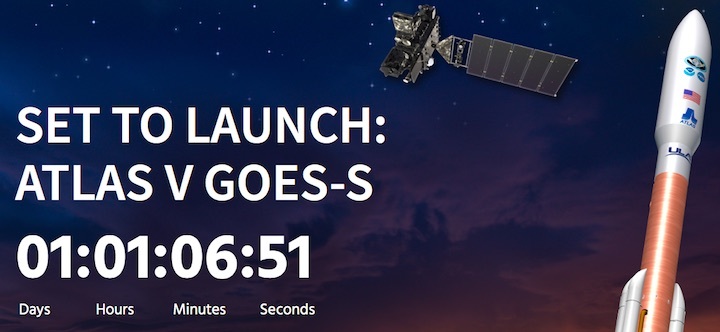
Quelle: ULA
---
Update: 1.03.2018 / 20.40 MEZ
.

+++

+++23.00 MEZ
+




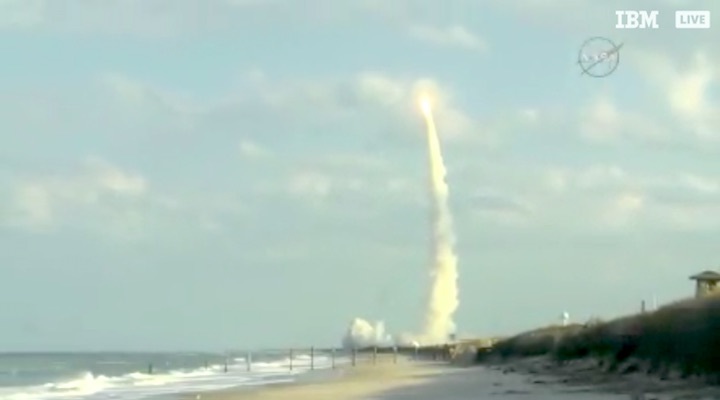




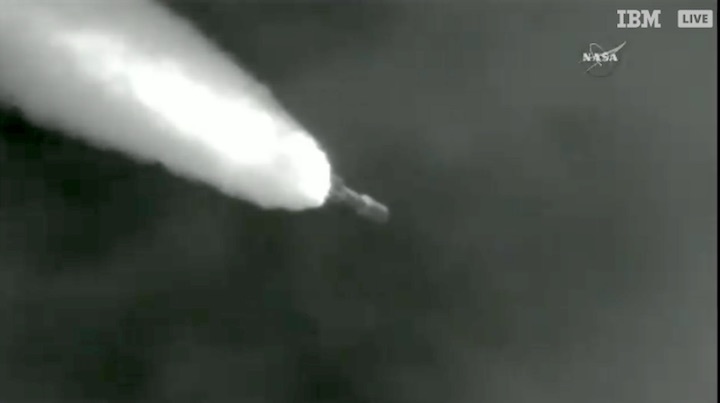



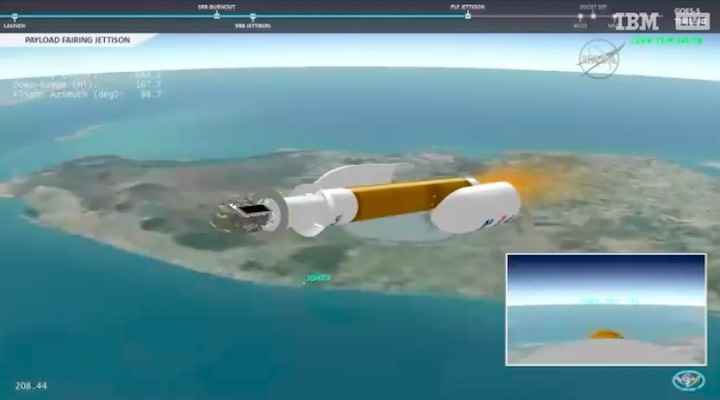



Quelle: NASA-TV
+++
NASA, ULA Launch Advanced NOAA Weather Satellite
NASA successfully launched the second in a series of next-generation weather satellites for the National Oceanic and Atmospheric Administration (NOAA) at 5:02 p.m. EST Thursday.
NOAA’s Geostationary Operational Environmental Satellite-S (GOES-S) lifted off on a United Launch Alliance (ULA) Atlas V rocket from Space Launch Complex 41 at Cape Canaveral Air Force Station in Florida.
GOES-S mission managers confirmed at 8:58 p.m. the spacecraft’s solar arrays successfully deployed and the spacecraft was operating on its own power.
The satellite will provide faster, more accurate and more detailed data, in near real-time, to track storm systems, lightning, wildfires, coastal fog and other hazards that affect the western United States.
“We at NASA Science are proud to support our joint agency partner NOAA on today’s launch of GOES-S, a national asset that will impact lives across the Western Hemisphere each and every day,” said Thomas Zurbuchen, NASA associate administrator for science, who attended today’s launch.
Once GOES-S is positioned in a geostationary orbit 22,300 miles above Earth, in approximately two weeks, it will be renamed GOES-17. Later this year, after undergoing a full checkout and validation of its six high-tech instruments, the new satellite will move to the GOES-West position and become operational. From there, it constantly will provide advanced imagery and atmospheric measurements, real-time mapping of lightning activity, and improved monitoring of solar activity and space weather.
In addition to improving weather forecasts, GOES-17 will help forecasters locate and track wildfires – invaluable information that emergency response teams need to fight fires and evacuate people out of harm’s way. GOES-17 also will be an important tool for forecasters to track and predict the formation and dissipation of fog, which can disrupt airport operations.
GOES-17 will work in tandem with GOES-16, the first satellite in NOAA’s new geostationary series, now at the GOES-East position. GOES-17 will extend observational high-resolution satellite coverage of the revolutionary new technology aboard GOES-16 to most of the Western Hemisphere, from the west coast of Africa to New Zealand, and from near the Arctic Circle to near the Antarctic Circle. The satellite will provide more and better data than is currently available over the northeastern Pacific Ocean, the birthplace of many weather systems that affect the continental U.S.
NOAA manages the GOES-R Series program through an integrated NOAA/NASA office at NASA’s Goddard Space Flight Center in Greenbelt, Maryland. NASA also oversees the acquisition of the spacecraft, instruments and launch vehicles. Lockheed Martin Space of Littleton, Colorado, built the spacecraft and is responsible for spacecraft development, integration and testing.
Mission operations will be performed by NOAA at the NOAA Satellite Operations Facility in Suitland, Maryland. Harris Corp. of Melbourne, Florida, provided the main instrument payload, the Advanced Baseline Imager, and the ground system, which includes the antenna system for data receipt. NASA’s Launch Services Program, based at the agency’s Kennedy Space Center in Florida, is responsible for launch management. ULA of Centennial, Colorado, is the provider of the Atlas V launch service.
Quelle: NASA

